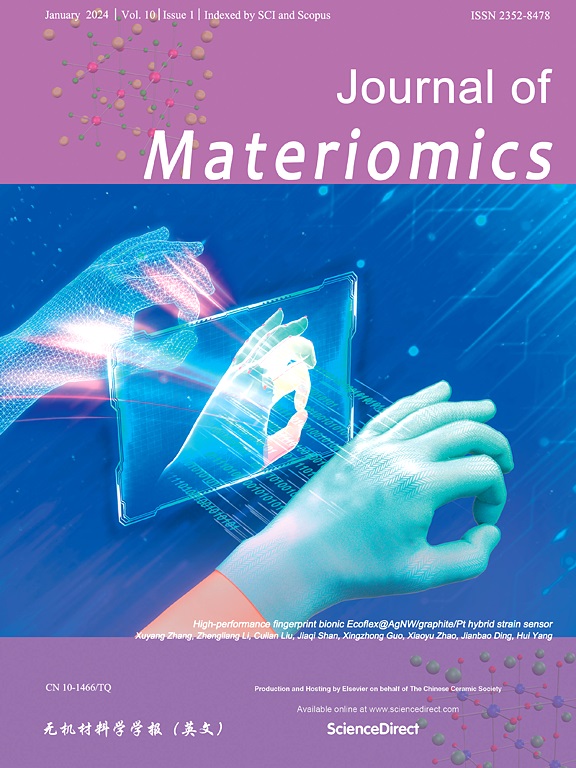通过扫描探针声学显微镜解析高能量密度 BaTiO3 铁电薄膜中的纳米晶粒形态和亚晶粒纳米域
IF 8.4
1区 材料科学
Q1 CHEMISTRY, PHYSICAL
引用次数: 0
摘要
电介质的储能特性与其纳米结构密切相关。在本研究中,我们通过探究集成在硅上的多晶 BaTiO3 薄膜中的纳米晶粒和亚晶粒纳米结构,旨在深入了解高能量密度铁电陶瓷薄膜中的这种关系。通过扫描探针声学显微镜分析发现,直接生长在铂/钛/硅上的 BaTiO3 薄膜大多由大的不连续柱状纳米晶粒组成,而生长在 LaNiO3 缓冲铂/钛/硅衬底上的薄膜则以连续柱状纳米晶粒的微观结构为主。此外,缓冲的 BaTiO3 薄膜晶粒内部显示出宽度为 10 纳米的超细铁弹性畴,而未缓冲的薄膜畴宽度增加了约 50%。BaTiO3 薄膜的介电性能与其特有的纳米结构密切相关。在电场增大的情况下,LaNiO3 缓冲薄膜的介电常数下降较慢,电极化饱和较晚,从而提高了储能性能。器件级充放电测试不仅验证了 LaNiO3 缓冲 BaTiO3 薄膜电容器的延迟极化饱和和高能量密度,而且还验证了与铁电陶瓷相同数量级的高功率密度。本文章由计算机程序翻译,如有差异,请以英文原文为准。

Resolving nanograin morphology and sub-grain nanodomains via scanning probe acoustic microscopy in high energy density BaTiO3 ferroelectric films
Energy storage property of a dielectric is closely tied with its nanostructure. In this study, we aim to achieve a deep understanding of this relationship in high energy density ferroelectric ceramic films, by probing into the nanograin and sub-grain nanostructures in polycrystalline BaTiO3 films integrated on Si. Through scanning probe acoustic microscopy analyses, it is revealed that the BaTiO3 films directly grown on Pt/Ti/Si mostly consist of large discontinuous columnar nanograins, while those grown on LaNiO3-buffered Pt/Ti/Si substrates have a dominant microstructure of continuous columnar nanograins. Furthermore, ultrafine ferroelastic domains of ∼10 nm wide are revealed inside the grains of the buffered BaTiO3 films, while those unbuffered films show about ∼50% increase in the domain width. The dielectric properties of the BaTiO3 films are well correlated with their characteristic nanostructures. Under an increasing electric field, the LaNiO3-buffered films display a slower decline in its dielectric constant and a later saturation of its electric polarization, leading to an improved energy storage performance. Device-level charge-discharge tests have verified not only the delayed polarization saturation and high energy density of the LaNiO3-buffered BaTiO3 film capacitors, but also a high power density in the same order as those of the ferroelectric ceramics.
求助全文
通过发布文献求助,成功后即可免费获取论文全文。
去求助
来源期刊

Journal of Materiomics
Materials Science-Metals and Alloys
CiteScore
14.30
自引率
6.40%
发文量
331
审稿时长
37 days
期刊介绍:
The Journal of Materiomics is a peer-reviewed open-access journal that aims to serve as a forum for the continuous dissemination of research within the field of materials science. It particularly emphasizes systematic studies on the relationships between composition, processing, structure, property, and performance of advanced materials. The journal is supported by the Chinese Ceramic Society and is indexed in SCIE and Scopus. It is commonly referred to as J Materiomics.
 求助内容:
求助内容: 应助结果提醒方式:
应助结果提醒方式:


